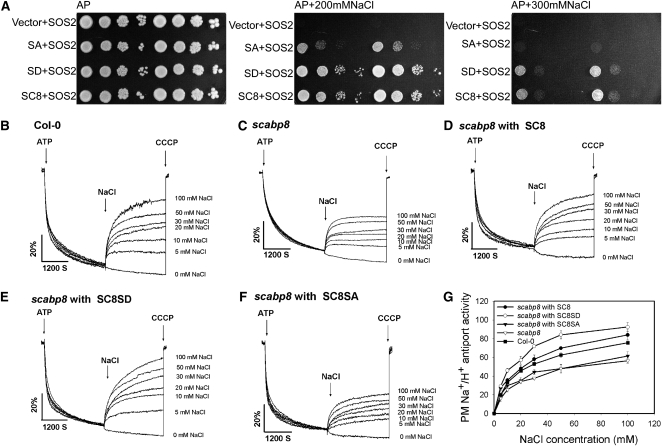Figure 7.
The Phosphorylation of SCaBP8 Affects Plasma Membrane Na+/H+ Antiport Activity.
(A) SCaBP8S237A cannot activate the SOS pathway in yeast. Yeast AXT3K cells lack the Na+ efflux proteins ENA1-4 and NHA1 and the vacuolar Na+/H+ antiporter NHX1. Expression of SOS1 activated by SOS2-SOS3/SCaBP8 complex can fully restore the NaCl tolerance. Yeast AXT3K cells expressing Arabidopsis SOS1 and transformed with the indicated combinations of Arabidopsis genes were grown overnight in liquid medium with 1 mM KCl. Five microliters of serial decimal dilutions were spotted onto plates of the same medium or media supplemented with 200 or 300 mM NaCl. Each plate has two replicates. Plates were incubated at 28°C for 4 d. AP, Arg phosphate.
(B) to (G) Plasma membrane–enriched vesicles were isolated from NaCl-treated wild-type (Col-0) and scabp8 plants. The Na+ transport assay was initiated by the addition of ATP, and formation of ΔpH was measured at excitation and emission wavelengths of 430 and 500 nm, respectively. When the pH gradient (ΔpH) reached steady state, NaCl was added over a range of final NaCl concentrations from 0 to 100 mM, and initial rates of Na+-induced dissipation of ΔpH were measured.
(B) and (C) Plasma membrane Na+/H+ antiport activity is reduced in the scabp8 mutant. Wild-type (Col-0) (B) and scabp8 (C) plasma membrane Na+/H+ antiport activity as a function of NaCl concentration.
(D) to (F) Recombinant SCaBP8 (D) and SCaBP8S237D (E) proteins stimulate plasma membrane Na+/H+ antiport activity in the scabp8 mutant, while SCaBP8S237A (F) does not.
(G) Na+/H+ antiport activity is reduced in the scabp8 mutant compared with the wild type over a range of NaCl concentrations. The units of Na+/H+ antiport activity are Δ%F/min/mg protein.
For (B) to (F), one representative experiment of three replicates is shown. For (G), data represent means ± se of at least three replicate experiments. Each replicate experiment was performed using independent membrane preparations. SC8, SCaBP8 protein; SC8SD, SCaBP8S237D protein; SC8SA, SCaBP8S237A protein; CCCP, m-chlorophenylhydrazone; PM, plasma membrane.

